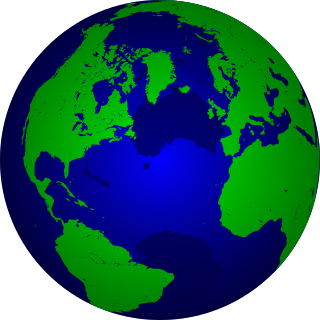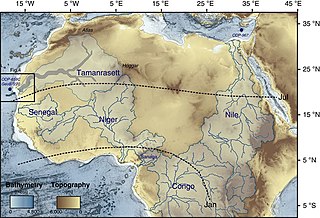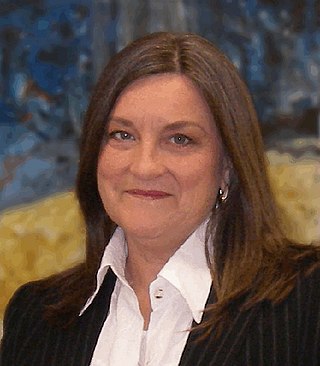Related Research Articles

Seth Carlo Chandler, Jr. was an American astronomer, geodesist, and actuary.

The American Geophysical Union (AGU) is a 501(c)(3) nonprofit organization of Earth, atmospheric, ocean, hydrologic, space, and planetary scientists and enthusiasts that according to their website includes 130,000 people. AGU's activities are focused on the organization and dissemination of scientific information in the interdisciplinary and international fields within the Earth and space sciences. The geophysical sciences involve four fundamental areas: atmospheric and ocean sciences; solid-Earth sciences; hydrologic sciences; and space sciences. The organization's headquarters is located on Florida Avenue in Washington, D.C.

Generic Mapping Tools (GMT) are an open-source collection of computer software tools for processing and displaying xy and xyz datasets, including rasterization, filtering and other image processing operations, and various kinds of map projections. The software stores 2-D grids as COARDS-compliant netCDF files and comes with a comprehensive collection of free GIS data, such as coast lines, rivers, political borders and coordinates of other geographic objects. Users convert further data from other sources and import them. GMT stores the resulting maps and diagrams in PostScript (PS) or Encapsulated PostScript (EPS) format.

GSHHG is a high-resolution shoreline data set amalgamated from two data bases in the public domain. The data have undergone extensive processing and are free of internal inconsistencies such as erratic points and crossing segments. The shorelines are constructed entirely from hierarchically arranged closed polygons. The four-level hierarchy is as follows: seashore, lakes, islands within lakes, ponds within islands within lakes.
Naoshi Fukushima was a Japanese physicist specializing in the near-Earth space environment. He served as Secretary General of the International Association of Geomagnetism and Aeronomy from 1975 to 1983. In 1990 he was awarded the AGU's Waldo E. Smith Award.
Vassilis Angelopoulos is a Greek American physicist. He is a specialist on space and astrophysical plasmas.
Pål Wessel, pronounced as, and also known as, Paul Wessel, is a professor of the Department of Geology and Geophysics at the School of Ocean and Earth Science and Technology (SOEST) at the University of Hawaiʻi at Mānoa. He has taught as a visiting professor at Sydney University in Australia and University of Oslo in Norway. Dr. Wessel is a Fellow of the Geological Society of America.

Alexander J. Dessler was an American space scientist known for conceiving the term heliosphere and for founding the first Space Science Department in the United States.

Susan E. Trumbore is an earth systems scientist focusing on the carbon cycle and its effects on climate. She is a director at the Max Planck Institute for Biogeochemistry and a Professor of Earth System Science at University of California, Irvine. She is a fellow of the American Geophysical Union and the American Association for the Advancement of Science, a Member of the National Academy of Sciences and recipient of the Benjamin Franklin Medal.

The Tamanrasset River is an enormous palaeoriver believed to have flowed through West Africa as recently as 5000 years ago during the African humid period. The Tamanrasset River basin is thought to have been comparable with the present-day Ganges-Brahmaputra river basin in Asia.
Emily V. Fischer is an atmospheric chemist and an associate professor in the department of atmospheric science at Colorado State University. She earned notoriety from her work on the WE-CAN project and on PAN, specifically its role in changing the distribution of oxidants in the troposphere. She has received many honors including the prestigious James B. Macelwane Medal which is "given annually to three to five early career scientists in recognition of their significant contributions to Earth and space science." Fischer is also a role model and activist in galvanizing support for women in STEM fields.

Nancy U. Crooker is an American physicist and professor emerita of space physics at Boston University, Massachusetts. She has made major contributions to the understanding of geomagnetism in the Earth's magnetosphere and the heliosphere, particularly through the study of interplanetary electrons and magnetic reconnection.
Vytenis Vasyliunas, FRS is a Lithuanian space scientist who was director of Germany's Max Planck Institute for Solar System Research from 1977 to 2007.

Catherine Ann McCammon is a Canadian geoscientist who is employed by the University of Bayreuth. Her research focuses on surface and mantle processes, as well as the physics and chemistry of minerals. She is a Fellow of the European Association of Geochemistry and American Geophysical Union. In 2013, she was awarded the European Geosciences Union Robert Wilhelm Bunsen medal. She is the editor of the journal Physics and Chemistry of Minerals.
Suzanne Carbotte is a marine geophysicist known for her research on the formation of new oceanic crust.

Patricia Reiff is an American space physicist at Rice University, known for her research on space weather and for engaging the public about science.
Margaret Ann ("Peggy") Shea is a space scientist known for research on the connections between cosmic radiation and Earth's magnetic field.

The SeaWiFS Bio-optical Archive and Storage System (SeaBASS) is a data archive of in situ oceanographic data used to support satellite remote sensing research of ocean color. SeaBASS is used for developing algorithms for satellite-derived variables and for validating or “ground-truthing” satellite-derived data products. The acronym begins with “S” for SeaWiFS, because the data repository began in the 1990s around the time of the launch of the SeaWiFS satellite sensor, and the same data archive has been used ever since. Oceanography projects funded by the NASA Earth Science program are required to upload data collected on research campaigns to the SeaBASS data repository to increase the volume of open-access data available to the public. As of 2021 the data archive contained information from thousands of field campaigns uploaded by over 100 principal investigators.

James Wynne "Jim" Dungey (1923–2015) was a British space scientist who was pivotal in establishing the field of space weather and made significant contributions to the fundamental understanding of plasma physics.
Sinéad Louise Farrell is a British-American space scientist who is Professor of Geographic Sciences at the University of Maryland, College Park. Her research considers remote sensing and climate monitoring. She was science lead for the ICESat-2 Mission, which used laser altimetry to make height maps of Earth.
References
- ↑ "Technical Sub-Committee of Ocean Mapping (TSCOM)". GEBCO . 2013. Archived from the original on December 20, 2022. Retrieved December 20, 2022.
- ↑ "Walter H.F. Smith - Satellite Oceanography & Climatology Division". NOAA. Archived from the original on November 17, 2019. Retrieved November 19, 2019.
- ↑ "UNION FELLOWS". American Geophysical Union. Archived from the original on March 10, 2022. Retrieved December 23, 2022.
- ↑ Wessel; Smith (1998). "New, improved version of generic mapping tools released". EOS. American Geophysical Union. 79 (47): 579. Bibcode:1998EOSTr..79..579W. doi: 10.1029/98EO00426 .
- ↑ Wessel; Smith (1996). "A global, self-consistent, hierarchical, high-resolution shoreline database" (PDF). Journal of Geophysical Research. American Geophysical Union. 101 (B4): 8741–8743. Bibcode:1996JGR...101.8741W. doi:10.1029/96JB00104 . Retrieved December 23, 2022.